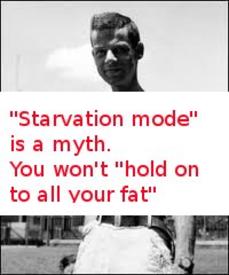We are pleased to announce that as of March 4, 2025, an updated Rich Text Editor has been introduced in the MyFitnessPal Community. To learn more about the changes, please click here. We look forward to sharing this new feature with you!
Question about protein consumption

Mr_Knight
Posts: 9,532 Member
Assuming you're moderately active and eating somewhere around 0.8g/pound of LBM - ie, "a lot" by normal standards but not at a big excess - how much of that protein is used for fuelling body functions and how much is used for repair/maintenance of lean body mass?
My understanding is that virtually all of it is used for body maintenance....?
My understanding is that virtually all of it is used for body maintenance....?
0
Replies
-
My metabolic rate test assumed 15% of my energy was coming from protein. The RDI for the majority of the population is way below 0.8 so I would assume half the 0.8 was used as protein for repair.
75g/day is an EU accepted intake for lean mass preservation during weight loss on a VLCD
I dare say the recent Protein Summit 2.0 had something relevant to say.0 -
My metabolic rate test assumed 15% of my energy was coming from protein. The RDI for the majority of the population is way below 0.8 so I would assume half the 0.8 was used as protein for repair.
75g/day is an EU accepted intake for lean mass preservation during weight loss on a VLCD
I dare say the recent Protein Summit 2.0 had something relevant to say.
Thanks for the pointer (link to report below). Here's an excerpt:Specifically, higher protein (i.e., 1.2 to 1.6g/kg/day), weight loss diets result in greater losses in body weight
and body fat, preservation of lean body mass and reductions in triglycerides, blood pressure and waist circumference
At that point we're close to the 0.8g/LBM-lb. If we have to go that high to optimize LBM preservation, wouldn't that suggest a large majority of protein intake is needed just for non-energy needs?
http://beefnutrition.org/CMDocs/BeefNutrition/Protein Supplement Research Summary.pdf
0 -
Should a report from a beef marketing organisation be used to form a conclusion?0
-
In for answers, I have no idea, but I'm definitely curious!0
-
If we take leucine, one of the protein amino acids, tracer studies show 90% of it is oxidised. http://m.ajpendo.physiology.org/content/275/2/E310.full etc and linked studies. There is a results chart showing increased oxidation of leucine in response to increased intake. Will look it up.
Google "anabolic threshold" and you'll see hypotheses about how many grams of protein or specific amino acids are required to prevent muscle loss / stimulate growth. 5 meals with inadequate protein per meal may add up to a different outcome to 3 meals which exceed the threshold.
Quality / composition of protein is important too - you many have to eat more low quality protein to hit requirement of certain amino acids.0 -

Intake of 1 vs 2.5 grams protein per kg body weight shows eating more results in more oxidation ie excess is "burned"0 -
I think this is a good read .. and the sources if you like to dig deeper
http://bayesianbodybuilding.com/the-myth-of-1glb-optimal-protein-intake-for-bodybuilders/
0 -
Thanks for the pointer (link to report below). Here's an excerpt:Specifically, higher protein (i.e., 1.2 to 1.6g/kg/day), weight loss diets result in greater losses in body weight
and body fat, preservation of lean body mass and reductions in triglycerides, blood pressure and waist circumference
At that point we're close to the 0.8g/LBM-lb. If we have to go that high to optimize LBM preservation, wouldn't that suggest a large majority of protein intake is needed just for non-energy needs?
http://beefnutrition.org/CMDocs/BeefNutrition/Protein Supplement Research Summary.pdf
Possibly, but changes in other macros are a complicating factor "Findings suggest that weight-loss diets containing higher protein (i.e., 1.2–1.6 g/kg body weight per day or 90–150 g) lead to modest, but relevant, improvements in body weight over the short term (≤12 wk) compared with standard-protein (higher-carbohydrate) diets."
http://m.ajcn.nutrition.org/content/101/6/1330S.full delves into the various roles of protein.
The RDA based on nitrogen balance is stated as 0.8 grams high quality protein per kg of body weight aka 0.36 grams per lb of body weight or maybe 0.5 grams per lb LBM in the non-lean.0 -
Right. The numbers will change based on ratios of the individual amino acids. That's a huge complication...
Thanks!
What prompted this was thinking through nutrient requirements in the PSMF style of VLCD case. If X % of protein isn't used for fuel but for "maintenance", then the daily caloric guidelines are using one bucket to hold two different flavors of soda. The idea of counting protein macros as a gram requirement rather than as a calorie requirement is a big step in accounting for this, but it seems we could still do a better job of differentiating between the two needs.
And because this is MFP, let me explicitly state: none of this violates CICO. 0
0 -
EFSA decided that a PSMF VLCD needs to have 75 grams a day of protein, 30 g/d of carbohydrate (not including fibre), 11 g/d of linoleic acid (omega-6) and 1.4 g/day of alpha-linolenic acid (ALA, omega-3) with a 600 kcal minimum (the above macro minimums add up to 530 or so).
If the 75g of protein supplied in the VLCD is "used" for maintenance then perhaps the thinking is that the 75g it replaces is oxidised for fuel ? Seems there is a constant flux of amino acids in the same way as fats are been released and stored.
Either way the PSMF VLCD is essentially a total fast with reduced risk of death, by providing heart maintenance protein etc. The number of calories isn't a goal per se it's just to ensure that the essentials are being supplied - I don't think VLCDs are prescribed at a certain calorie deficit.0 -
It's a report from a meat and dairy protein industry funded event, not a study in itself, and cites studies which are not freely available thus I can't comment on whether the observations and conclusions cited within the report are reasonable or not. It's easy to cherry-pick quotations from "meta-analysis" studies (not new pure research) to support conclusion, sometimes any conclusion.
Among some principals cited in the studies are those who promote or lend their name to weight loss products marketed by MLM systems (Donald K Layman -> Qivana -> Metaboliq). I didn't bother researching other names.
A sceptical eye is not an unhealthy condition to suffer from is all that I am trying to convey.
0 -
It's a report from a meat and dairy protein industry funded event, not a study in itself, and cites studies which are not freely available thus I can't comment on whether the observations and conclusions cited within the report are reasonable or not. It's easy to cherry-pick quotations from "meta-analysis" studies (not new pure research) to support conclusion, sometimes any conclusion.
Among some principals cited in the studies are those who promote or lend their name to weight loss products marketed by MLM systems (Donald K Layman -> Qivana -> Metaboliq). I didn't bother researching other names.
A sceptical eye is not an unhealthy condition to suffer from is all that I am trying to convey.
Yes, scepticism is great and health and etc....but I'm not a believe in scepticism for the sake of scepticism.
Nothing being discussed here depends on anything in that report, and nobody has pointed out any actual errors in the report.
If there is something wrong in there, I would very much appreciate hearing it.
0 -
Assuming you're moderately active and eating somewhere around 0.8g/pound of LBM - ie, "a lot" by normal standards but not at a big excess - how much of that protein is used for fuelling body functions and how much is used for repair/maintenance of lean body mass?
My understanding is that virtually all of it is used for body maintenance....?
Body weight in grams or of you need more, body weight x 1.40 -
beccahbase wrote: »Body weight in grams or of you need more, body weight x 1.4
my bodyweight in grams is 83000
what next ?
0 -
-
It's a report from a meat and dairy protein industry funded event, not a study in itself, and cites studies which are not freely available
http://ajcn.nutrition.org/content/101/6/1317S.long has five free full text links to other papers from the event.0 -
Great intelligent thread discussion, thank you for this0
This discussion has been closed.
Categories
- All Categories
- 1.4M Health, Wellness and Goals
- 391.6K Introduce Yourself
- 43.5K Getting Started
- 260.5K Health and Weight Loss
- 175.6K Food and Nutrition
- 47.3K Recipes
- 232.7K Fitness and Exercise
- 392 Sleep, Mindfulness and Overall Wellness
- 6.4K Goal: Maintaining Weight
- 8.6K Goal: Gaining Weight and Body Building
- 153.1K Motivation and Support
- 8.1K Challenges
- 1.3K Debate Club
- 96.3K Chit-Chat
- 2.5K Fun and Games
- 4K MyFitnessPal Information
- 16 News and Announcements
- 1.2K Feature Suggestions and Ideas
- 2.7K MyFitnessPal Tech Support Questions





